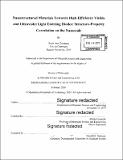| dc.contributor.advisor | Silvija Gradecǎk. | en_US |
| dc.contributor.author | Goodman, Sarah Ann. | en_US |
| dc.contributor.other | Massachusetts Institute of Technology. Department of Materials Science and Engineering. | en_US |
| dc.date.accessioned | 2020-05-26T23:14:13Z | |
| dc.date.available | 2020-05-26T23:14:13Z | |
| dc.date.copyright | 2020 | en_US |
| dc.date.issued | 2020 | en_US |
| dc.identifier.uri | https://hdl.handle.net/1721.1/125472 | |
| dc.description | Thesis: Ph. D., Massachusetts Institute of Technology, Department of Materials Science and Engineering, 2020 | en_US |
| dc.description | Cataloged from PDF version of thesis. | en_US |
| dc.description | Includes bibliographical references (pages 163-178). | en_US |
| dc.description.abstract | Lighting applications account for 15% of the world's energy consumption, indicating that highly efficient light emitting diodes (LEDs) have a tremendous potential to decrease energy usage. While LEDs are becoming more common in applications from households to industry, a number of improvements must be made to allow LEDs to achieve their maximum efficiency. In this thesis, we examine InGaN/GaN multiple quantum well (MQW) LEDs, which set the industry standard for blue/green inorganic LEDs with an external quantum efficiency of 70%. However, these LEDs suffer from efficiency droop, a phenomenon in which the device efficiency decreases past a certain threshold current. Additionally, the material quality suffers because lattice mismatches introduce defects into the device. We first examine electron energy-loss spectroscopy (EELS) as a method to investigate In fluctuations within the quantum wells, which are thought to contribute to efficiency droop. | en_US |
| dc.description.abstract | EELS has been extensively utilized in the literature to characterize QW composition, but as highƯ resolution aberration-corrected scanning transmission electron microscopy (STEM) becomes the standard. investigations of the impact of the electron beam on the sample and EELS analysis are required. Here, we demonstrate imaging parameters for which beam-induced carbon deposition leads to the introduction of artifacts in EELS spectra. We find that with decreasing pixel sizes for EELS maps, carbon accumulates on the sample, causing an increase in the multiple scattering plasmons of carbon to interfere with the power-law background subtraction of the In pre-edge. This effect is demonstrated across three state-of-the-art aberration-corrected STEM platforms, showing the ubiquitous nature of carbon contamination even in the most advanced instruments. Next, we investigate the spectral broadening around V-pit defects in InGaN/GaN MQW LEDs. | en_US |
| dc.description.abstract | As V-pit engineering, the practice of intentionally introducing V-pits into an LED in order to improve the efficiency, becomes more widespread, it is critical to understand the impact of VƯpits on the emission spectrum of LEDs. Here, we use cathodoluminescence (CL) spectroscopy within the S/TEM to identify three distinct regions of emission around V-pits. We identify blueƯ-shifted emission in the QWs of the V-pit sidewalls and confirm that the blue shift is due to reduced In composition. We find blue-shifted emission in the c-plane QWs adjacent to and in between V-pits that have been perturbed by strain-relaxation induced by V-pit formation. To take advantage of the V-pit-induced spectral broadening of the LED emission spectrum, we present a nanotextured device architecture based on V-pit overlap that emits broadly over a 100 nm range and does not require a nanofabricated template. | en_US |
| dc.description.abstract | The efficiency of InGaN-based LEDs can be improved by tackling phenomena within the material that lead to nonradiative recombination, but efficiency can also be increased by implementing additional structural features to the LEDs that can enhance emission, particularly for UV LEDs that generally suffer from low efficiency. Here, we extend the energy range of surface plasmons in aluminum nanodisks into the UV by controlling the nanodisk diameter using high-resolution electron beam lithography. We use STEM-EELS to map the complete plasmonic spectrum of aluminum nanodisks from 3-120 nm in diameter, achieving surface plasmons in the range of 2-10 eV. Additionally, investigations of the surface and volume plasmon decay at the nanodisk boundary open up pathways for further understanding of electron beam-matter interactions. This thesis work is motivated by the growing need for sustainable lighting sources. | en_US |
| dc.description.abstract | and we tackle this topic by providing new insights into a common methodology used for investigating sources of efficiency droop, analyzing the impact of defects used for efficiency improvement on LED emission. and by pushing the surface plasmon energies of aluminum nanostructures into the UV for the possibility of incorporation into UV LEDs for efficiency enhancement. | en_US |
| dc.description.statementofresponsibility | by Sarah Ann Goodman. | en_US |
| dc.format.extent | 178 pages | en_US |
| dc.language.iso | eng | en_US |
| dc.publisher | Massachusetts Institute of Technology | en_US |
| dc.rights | MIT theses are protected by copyright. They may be viewed, downloaded, or printed from this source but further reproduction or distribution in any format is prohibited without written permission. | en_US |
| dc.rights.uri | http://dspace.mit.edu/handle/1721.1/7582 | en_US |
| dc.subject | Materials Science and Engineering. | en_US |
| dc.title | Nanostructured materials towards high-efficiency visible and ultraviolet light emitting diodes : structure-property correlation on the nanoscale | en_US |
| dc.type | Thesis | en_US |
| dc.description.degree | Ph. D. | en_US |
| dc.contributor.department | Massachusetts Institute of Technology. Department of Materials Science and Engineering | en_US |
| dc.identifier.oclc | 1155052493 | en_US |
| dc.description.collection | Ph.D. Massachusetts Institute of Technology, Department of Materials Science and Engineering | en_US |
| dspace.imported | 2020-05-26T23:14:11Z | en_US |
| mit.thesis.degree | Doctoral | en_US |
| mit.thesis.department | MatSci | en_US |
